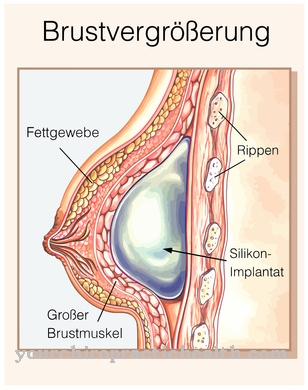The Chelation therapy serves to detoxify the body in acute and severe chronic heavy metal poisoning. However, this method is controversial for use in the case of minor poisoning and for the prevention of arteriosclerosis.
What is Chelation Therapy?

Chelation therapy is a method used to remove heavy metals from the body. As the name suggests, so-called chelating agents are used in this process. Chelating agents combine with metal ions to form complexes that can then be flushed out of the body.
In the event of acute intoxication, the poison centers are available for the authorized use of these substances. Chronic heavy metal poisoning is treated by environmental medicine specialists and members of the German Medical Association for Clinical Metal Toxicology with the help of chelating agents and recorded accordingly. The procedure is very effective in acute or severe chronic heavy metal poisoning.
Other applications are rather controversial and are even rejected by specialists. In many naturopathic practices, however, this procedure is also used to treat or prevent diseases that are allegedly caused by heavy metal poisoning. So far, no proof of the effectiveness of chelation therapy has been found in these applications.
Function, effect & goals
Chelation therapy is used today if the body is severely poisoned with heavy metals. It is a very effective way to detoxify the body. The complexing agents are administered either orally or as an infusion in solution.
The toxicity of heavy metals is based on their ability to form complexes with vital enzymes. As a result, these enzymes are no longer available to the body, which leads to considerable disturbances in the metabolic processes. This is where the chelating agents come into play, which compete with the enzymes to form complexes with heavy metals. EDTA (ethylenediaminetetraacetic acid), DMSA (dimercaptosuccinic acid) or DMPS (dimercaptopropane sulfonic acid) act as chelating agents.
These substances each contain several functional groups with which they can bind to a metal ion. They enclose the ion so that it forms the center of the resulting complex compound. This complex as an independent compound is water-soluble and can be easily flushed out of the body. EDTA forms particularly stable complexes with copper, nickel, iron or cobalt ions. But mercury, lead and calcium also form complexes with ETDA.
DMSA has proven itself in acute poisoning with lead, mercury and arsenic. The data situation is not yet sufficient for its use in chronic heavy metal poisoning. However, good experiences have been made with DMSA in the chronic intoxication of lead in childhood. The chelating agent DMPS (dimercaptopropane sulfonic acid) is used under the trade name Dimaval or Unithiol for poisoning with lead, mercury, arsenic, gold, bismuth, antimony and chromium. It is not suitable for use with iron, cadmium, thallium and selenium poisoning.
In addition to being used for heavy metal poisoning, chelating agents are also used for a severe copper storage disease, Wilson's disease. In this genetic disease, the copper from food cannot be processed properly by the body. Copper deposits occur in the various organs, especially in the liver, eyes and central nervous system. This disease is therefore a severe copper poisoning that can be fatal. Wilson's disease is well treatable with chelation therapy in combination with other therapy methods.
Risks, side effects & dangers
In naturopathic practices, chelation therapy is often used not only for acute and severe chronic heavy metal poisoning, but also for other diseases that are said to be caused by light heavy metal influences. However, these effects have not been scientifically proven.
On the contrary, these applications are rejected by many specialists. For example, it is said that the use of chelating agents can prevent various diseases such as cancer, arteriosclerosis, rheumatism, Alzheimer's disease, poor eyesight, psoriasis or osteoarthritis. The idea is that the body is always exposed to a low concentration of heavy metals, for example through fine dust pollution from industry and road traffic. The heavy metals are said to be responsible for the formation of free radicals that favor or trigger all these diseases.
A direct influence of calcium was even discussed in arteriosclerosis. Because calcium can also be intercepted by the complexing agents, chelation therapy should help prevent the onset of arteriosclerosis. However, it has been shown that calcium is not at all relevant for the development of arteriosclerosis. Even the original proponents of this theory had to admit that. In order to be able to justify the use of chelating agents for the prevention and treatment of arteriosclerosis, their antioxidant effect is now emphasized. However, studies have shown that the use of chelation therapy has no effect on the state of health and is also unsuitable for the prevention of degenerative diseases.
Alleged improvements in general health were either due to coincidences or were due to the placebo effect. In these cases, the chelation therapy is at best ineffective. What is worse, however, is the fact that complexing agents cannot distinguish between harmful metals and natural vital minerals. If chelation therapy is only used to prevent or treat degenerative diseases, it can ultimately even lead to mineral deficiencies.
The users of this therapy even point out the contraindications for heart failure, severe kidney and liver dysfunction, lung diseases or dementia. It is also pointed out that the treatment always takes place in combination with mineral substitution. However, this does not change their ineffectiveness in this application. In contrast to this, chelation therapy is always the most effective method when there is a high level of heavy metal exposure.













.jpg)

.jpg)
.jpg)











.jpg)